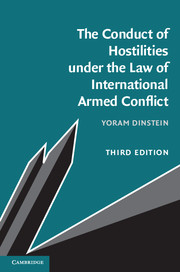Book contents
- Frontmatter
- Contents
- Introduction to the Third Edition
- Preface
- Table of cases
- Table of treaties
- List of abbreviations
- 1 The general framework
- 2 Lawful combatancy
- 3 Prohibited weapons
- 4 Lawful targets of attack
- 5 Protection from attack of civilians and civilian objects
- 6 Measures of special protection from attack
- 7 Protection of the environment
- 8 Specific methods of warfare
- 9 War crimes, orders, command responsibility and defences
- General conclusions
- Index of persons
- Index of subjects
5 - Protection from attack of civilians and civilian objects
Published online by Cambridge University Press: 05 April 2016
- Frontmatter
- Contents
- Introduction to the Third Edition
- Preface
- Table of cases
- Table of treaties
- List of abbreviations
- 1 The general framework
- 2 Lawful combatancy
- 3 Prohibited weapons
- 4 Lawful targets of attack
- 5 Protection from attack of civilians and civilian objects
- 6 Measures of special protection from attack
- 7 Protection of the environment
- 8 Specific methods of warfare
- 9 War crimes, orders, command responsibility and defences
- General conclusions
- Index of persons
- Index of subjects
Summary
Protection from attack
369. Notwithstanding LOIAC strictures, it is impossible to preclude altogether the possibility of civilian casualties and damage to civilian objects in wartime. Indeed, some civilian losses and damage are virtually postulated, as long as they constitute lawful collateral damage (see infra 408 et seq.). However, the obligation of Belligerent Parties to distinguish at all times between civilians and combatants – as well as between civilian objects and military objectives – is the mainspring of LOIAC as it currently stands and as reflected in Article 48 of AP/I (quoted supra 273). Contentions (voiced chiefly during World War II) to the effect that ‘[t]he distinction between combatant and non-combatant has all but vanished’ are utterly at odds with present-day LOIAC.
Civilians and civilian objects
(a) Definition of civilians
370. Civilians (not directly participating in hostilities) are non-combatants. Article 50(1) of AP/I defines civilians as persons who do not belong to one of the categories of persons referred to in Article 4(A)(1), (2), (3) and (6) of Geneva Convention (III), as well as in Article 43 of AP/I, adding that ‘[i]n case of doubt whether a person is a civilian, that person shall be considered to be a civilian’.
371. The texts referred to in Article 50(1) are quoted in full supra 133 and 163. The cited paragraphs of Article 4(A) of Geneva Convention (III) advert to members of regular armed forces (even when professing allegiance to unrecognized Governments), members of resistance movements, and levée en masse. Article 43 of AP/I defines armed forces. The hallmark of true civilians is that they are neither members of the armed forces nor do they directly participate in hostilities (see infra 469 et seq.).
372. The principal feature of civilian status is that – under Article 51(1) of AP/I – those entitled to it are supposed to ‘enjoy general protection against dangers arising from military operations’. Once a civilian joins the armed forces of a Belligerent Party or takes a direct part in hostilities, he will be exposed to danger. But as long as he remains a genuine civilian, he is cloaked by civilian protection.
(b) Civilians who accompany the armed forces
373. Under Article 4(A)(4) of Geneva Convention (III) (quoted supra 133), ‘[p]ersons who accompany the armed forces without actually being members thereof’, including ‘members of labour units’ and ‘supply contractors’, are entitled – if captured – to POW status.
- Type
- Chapter
- Information
- Publisher: Cambridge University PressPrint publication year: 2016

